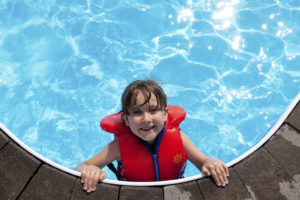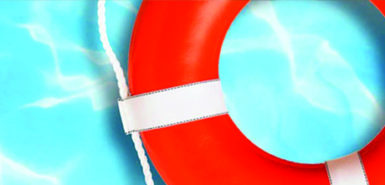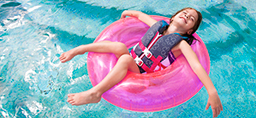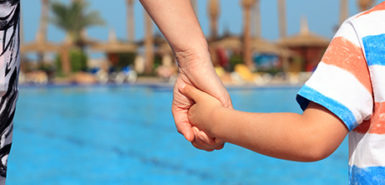
Summer is in full splash mode.
From squirt guns and sprinklers to home spas, pools, lakes and oceans, water is synonymous with fun.
Not to throw water on the party, but let’s talk water safety before you grab the sunscreen. It could save a young life this summer.
Erica Michiels, MD, a pediatric emergency physician at Spectrum Health Helen DeVos Children’s Hospital, is passionate about helping families avoid the very real danger of drowning.
“Most water-related trauma is preventable,” she said. “If I can help families take steps to avoid the devastating results of water accidents, I’m going to do it.”
Practice home water safety
While it’s not just a summertime thing, we have to start by saying that for families with kids younger than 4, water risks start at home, with the bathtub.
“Of course a parent isn’t thinking it’s risky to run to the kitchen from the bath for just a minute,” Dr. Michiels said. “But even one minute can be too long. My No. 1 rule is that there must be 100% supervision of every child from 0 to 4, every time there is water that goes beyond a Dixie cup.”
The greatest risk for kids under 4 is accidental water entry. If a child can get to water of any kind, there is significant risk. Swimming pools and spas must be securely covered and kept off limits with fencing and secure gates around a pool. A small child can slip under many pool covers.
Check gate latches to make sure unsupervised children can’t access the area. And treat a shallow kiddie pool with the same deference.
“If a toddler slips in unsupervised, it might as well be an ocean,” she said.
Beach and open water safety
The Centers for Disease Control and Prevention report that 10 children die per day from water-related incidents in America. Families living near the Great Lakes and other inland lakes may be at even higher risk.
Enjoying the beach is fantastic family fun. Practicing a few safety precautions will make sure the day stays fun.
“Make it easy by keeping kids in personal flotation devices all the time,” Dr. Michiels advised. “They can still play in the sand while wearing a (life jacket). And it gives you time if something goes wrong.”
That said, Dr. Michiels stresses that a life jacket is not a substitute for supervision. A designated responsible adult should be assigned to specific children within the group.
“There are lots of examples of children who drowned when handfuls of adults were nearby, but no one was specifically assigned to watch the kids,” she said. “Designating certain children to certain adults adds protection from a child being overlooked.”
Creeks, rivers and boating
Creeks and rivers add a potentially dangerous element. The current can sweep a child out of reach and out of sight quickly. Never allow play on the banks without a watchful adult for every child.
Properly fitting life jackets, barricaded play areas and even the controversial toddler leads can prevent a tumble into the water.
As kids get older and become stronger swimmers, it’s easy to overlook ongoing risk. Additionally, teens may have opportunities to participate in boating and personal watercraft activities.
Dr. Michiels offered more smart talk for water safety and teens:
- A personal flotation device must be worn, even if you are a good swimmer.
- Complete a boating safety course.
- Only allow the number of riders for which the personal watercraft or boat is designed to carry.
- No horsing around, whether on piers, docks, boats, rafts or personal watercraft.
- Discuss the dangers of alcohol and drugs with boating. Many boating fatalities involve drinking or drugs.
In case of emergency
Dr. Michiels said the best practice to assist a child (or any person) who is pulled from the water has changed in recent years.
“If you pull a child from the water and they cough, sputter but are awake, call 911 and stay with them,” she said. “The child may not be able to catch his or her breath, but we no longer advise trying to pump or extract inhaled water. If the child is limp and not breathing, call 911 and start CPR compressions immediately.”
Previously the medical community advised the rescuer to determine if the child was breathing and try to extract water. Today, rescuers are advised to start compressions immediately only if the victim is limp and unresponsive.
Don’t want to risk it? Splash Pad it!
To enjoy water when you don’t have enough supervision to ensure the safety of multiple tykes, check out splash and sprinkler parks near you.
These are often free, and offer crazy fun water play without drowning risk. That said, if the area is concrete, scrapes, stitches and even bone breaks are possible. Many splash parks feature rubberized surfaces.
Just use common sense and take a minute to assess when you arrive.
 /a>
/a>
 /a>
/a>
 /a>
/a>